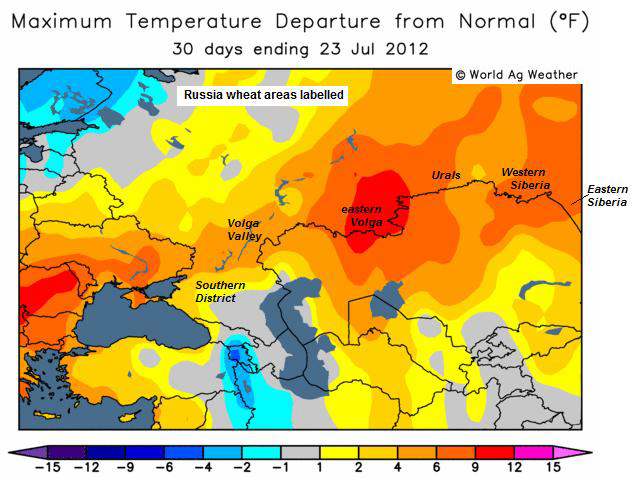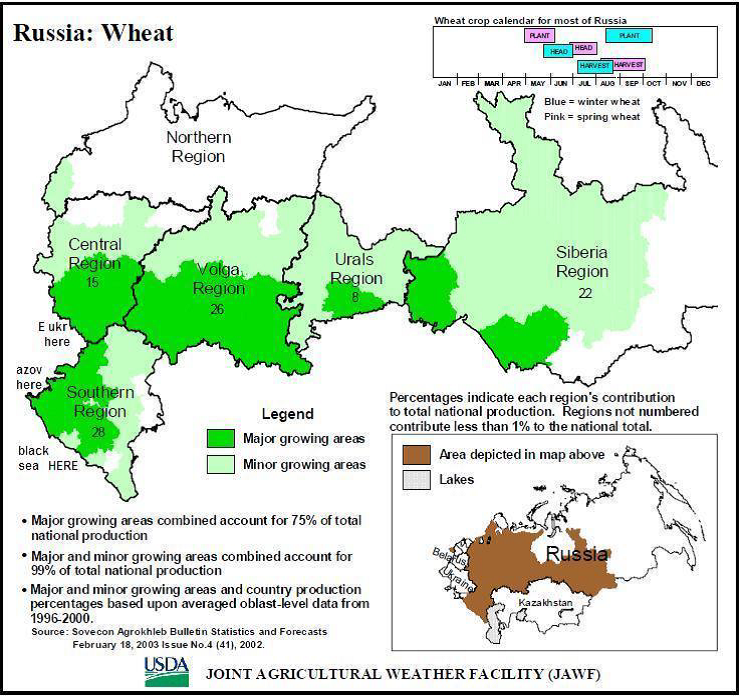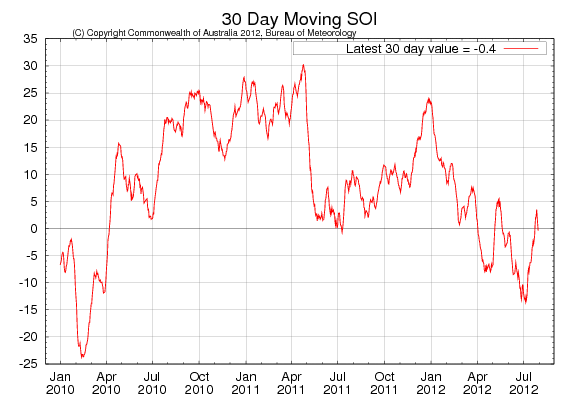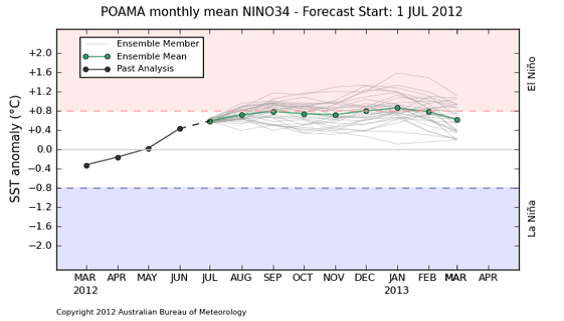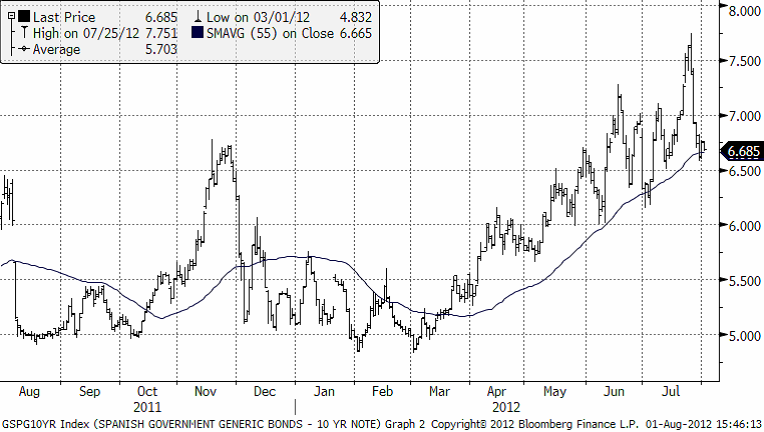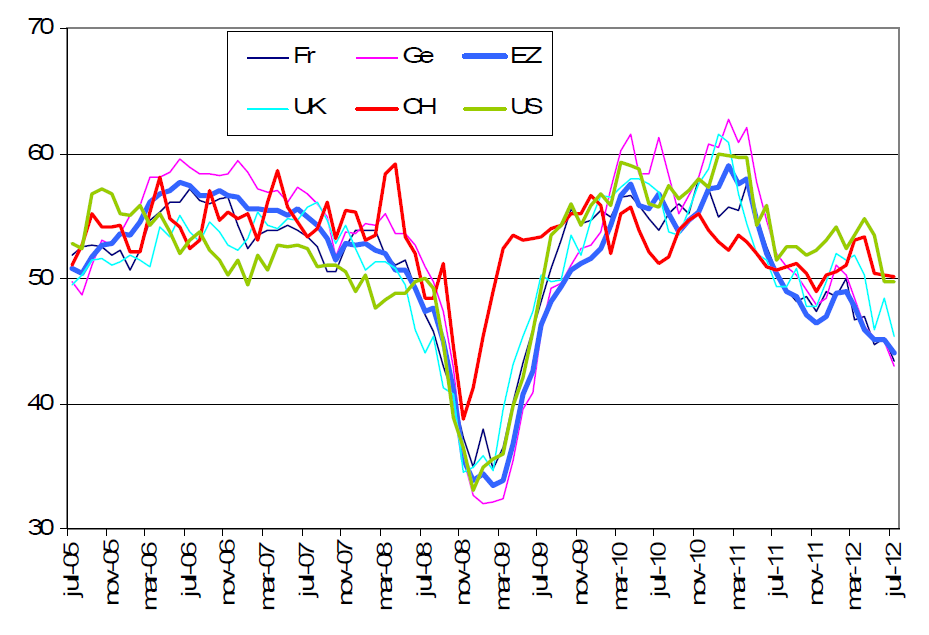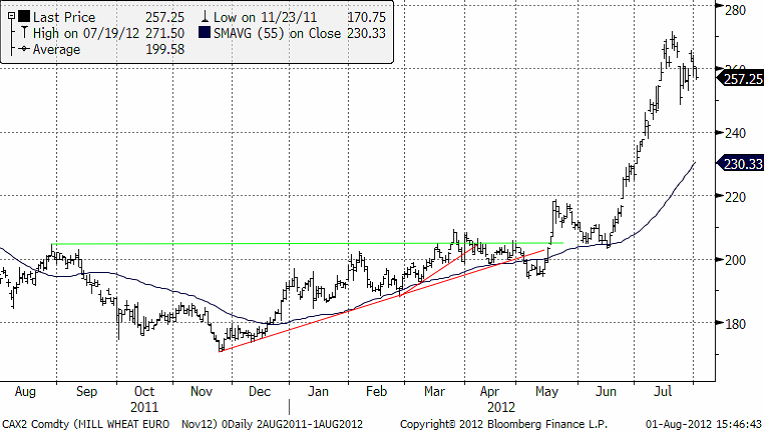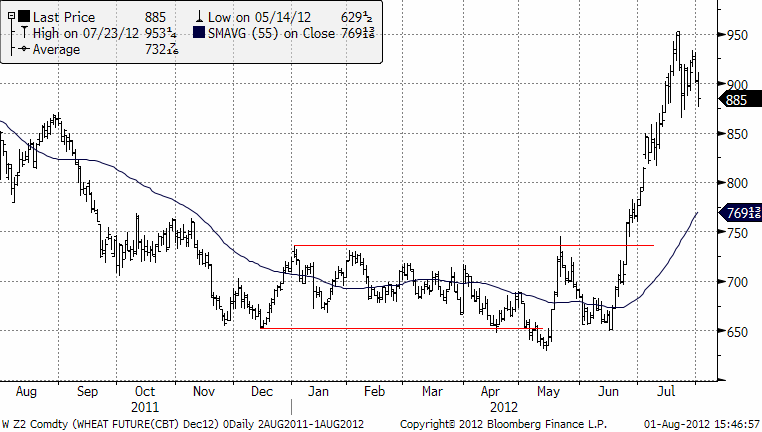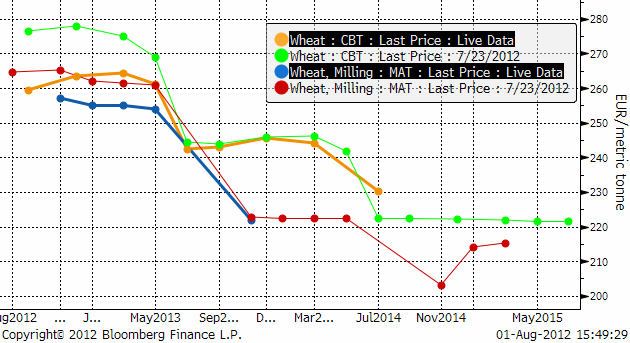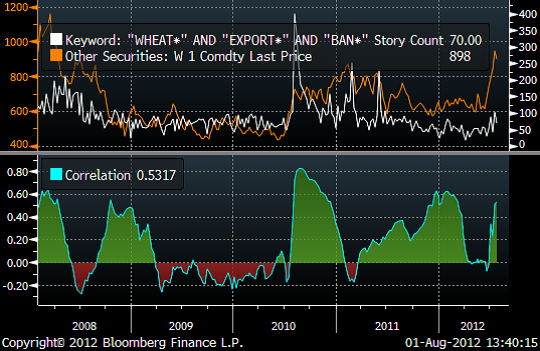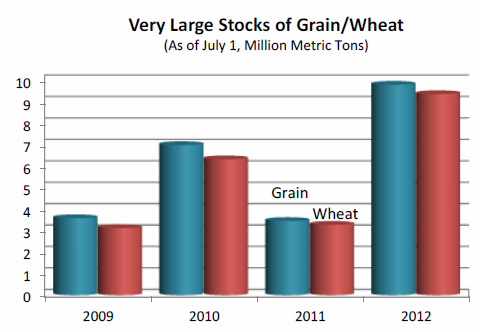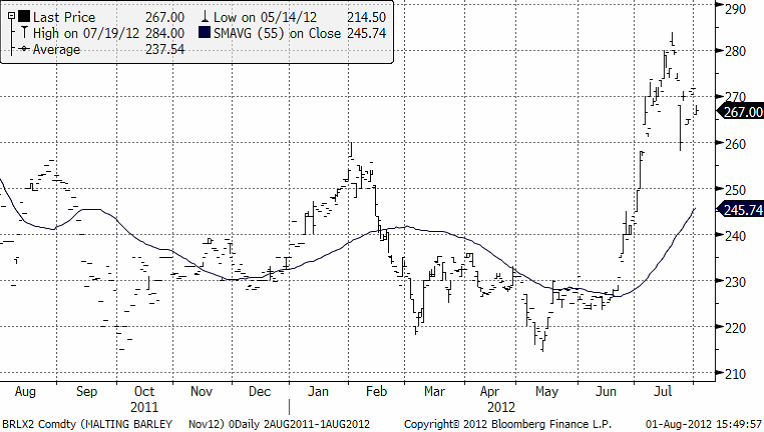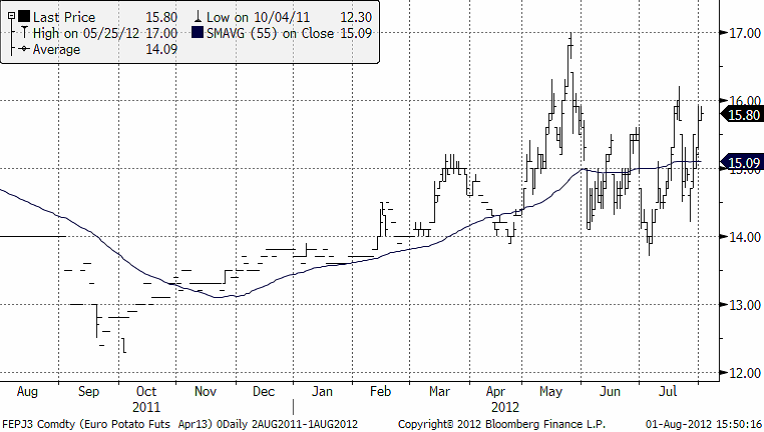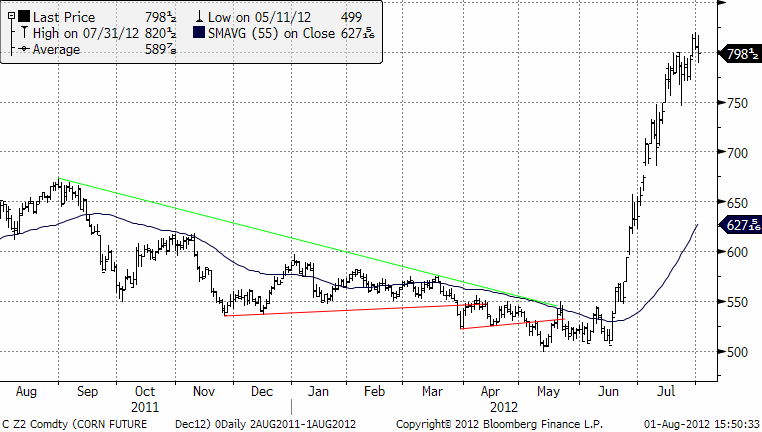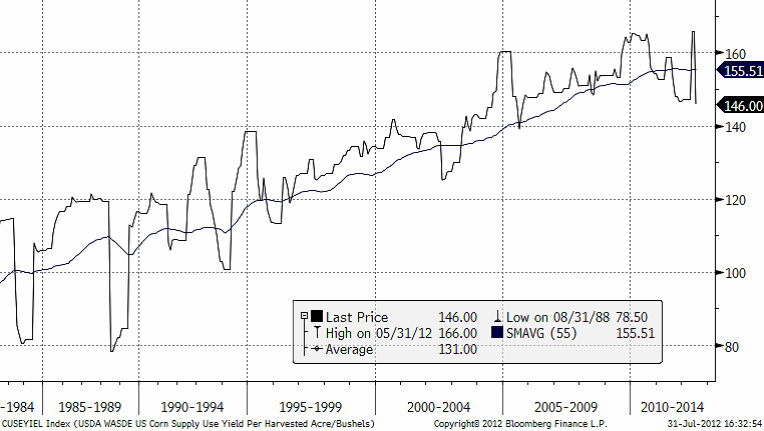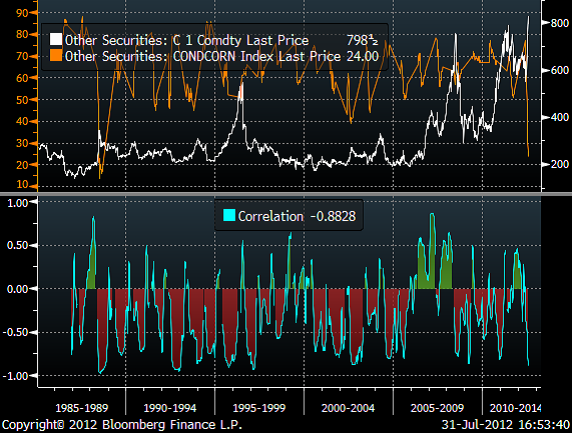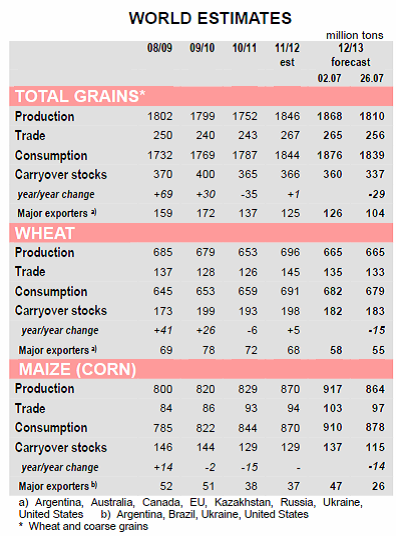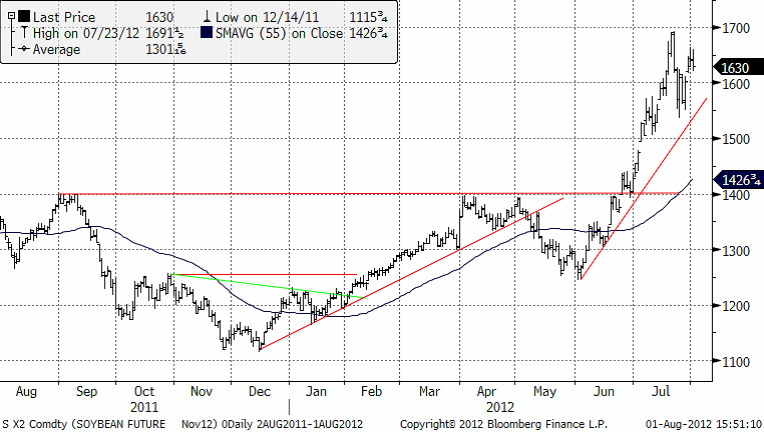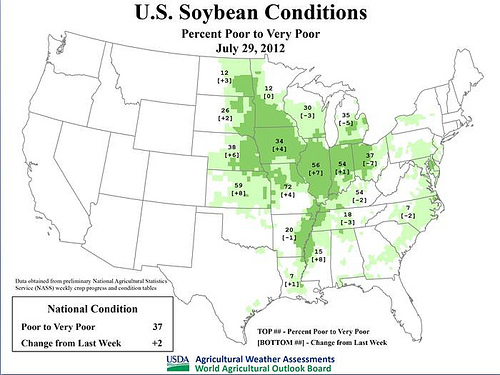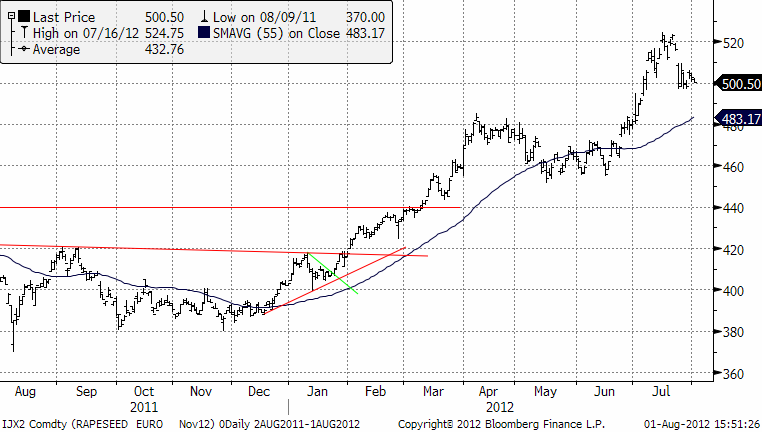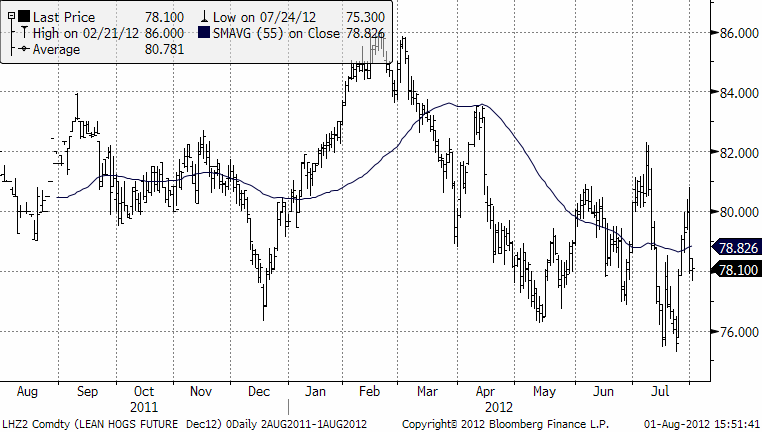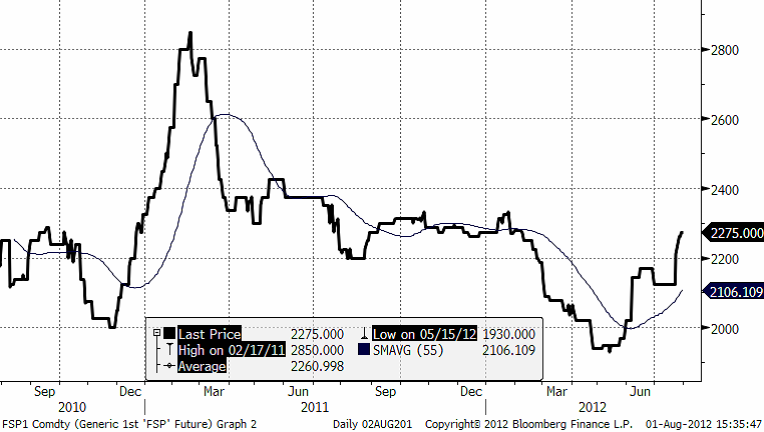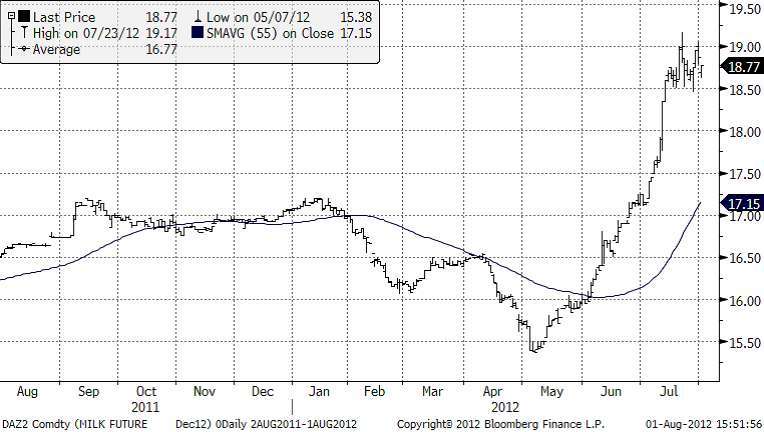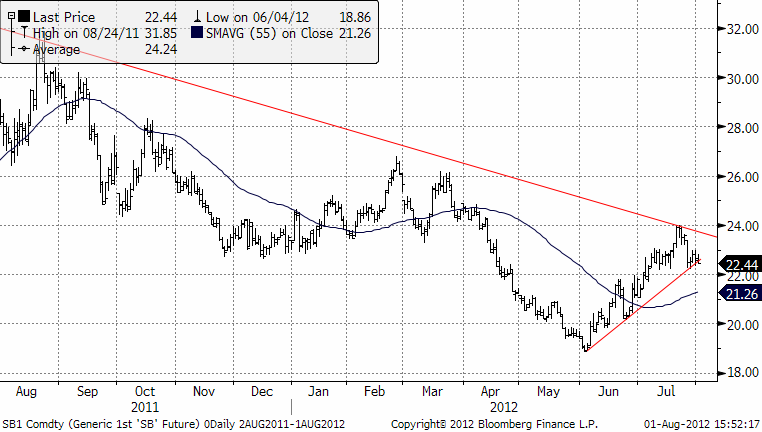Analys
SEB Jordbruksprodukter, 2 augusti 2012
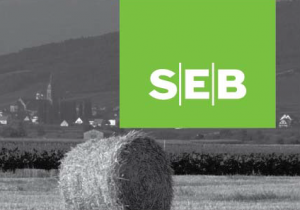 Inledning
Inledning
Den senaste veckan har priserna inte rört sig mycket. Även orderflödet har varit lugnare. Folk verkar ha stannat upp och funderat på vad som kommer att hända härnäst. På fredag nästa vecka publicerar USDA augustis WASDE-rapport. Kanske kommer det att vara lugnt fram tills den rapporten ger mer vägledning.
Vi fortsätter att ha en vy om högre priser på vete, maltkorn, majs, och sojabönor. Priset på socker står och väger, vid ett vägskäl, kan man säga.
Odlingsväder
Bilder på det varma vädret i Ryssland och Svartahavsområdet börjar komma ut nu. Nedan ser vi en kartbild publicerad av Martell Crop Projections.
Southern Oscillation Index har tagit sig upp till neutrala förhållanden igen, men det anses vara temporärt, eftersom de flesta prognosmodeller pekar på att ENSO ska vara nära El Niño-förhållanden, dvs med SOI närmare eller lägre än -8.
Australiensarnas prognos för ENSO pekar som vi ser nedan på att El Niño kan utveckla sig under hösten, men att det än så länge är osäkert. ENSO surfar precis på gränsen till El Niño.
Eurokrisen
Vad som sker i EU är att det finns en social acceptans att banker tas över av staten därför att man inte vill uppleva obehaget av att bankerna går under var och en för sig, Detta gör att det är rimligt att anta att staternas i fråga egentliga skulder är deras egen statsskuld + bankernas skulder. När man studerar den typen av skuldberg i förhållande till de här ländernas skatteintäkter, får man en skrämmande bild. Än så länge försöker man skjuta upp det oundvikliga. ECB:s satsning på att få ner räntorna i Spanien är det senaste och främsta exemplet på detta. Vi ser nedan hur räntorna har på deras tioårs statsobligation har fallit från 7.75 till 6.68. Förmodligen får vi se räntemarknaden ta ett nytt kliv uppåt inom kort. Skuldberg av den här storleken blir man av med genom att inte betala (skuldnedskrivning / konkurs) eller genom att betala med nytryckta pengar (inflation).
Inköpschefsindex, PMI, för de stora ekonomierna har sjunkit stadigt det senaste året. Tysklands PMI för tillverkningsindustrin ligger nu under Frankrikes, på 43 mot 43.4. Eurozonen ligger på 44. Storbritannien har bromsat in fort de senaste tre månaderna och har sjunkit från 50.2 i april till 45.4 i juli. USA har halkat under 50. Endast Kina ligger över 50. Gårdagens kinesiska PMI kom in på 50.1, vilket är en tiondel lägre än i juni (50.2). PMI anses vara en ”ledande indikator” för ekonomins utveckling.
PMI, som är en ledande indikator, är för Eurozonen på samma nivå som månaden före Lehmankraschen 2008.
Vete
Matifvetet med novemberleverans nådde upp till 271.50 den 19 juli, men har sedan dess rekylerat ner till 257.25 euro i skrivande stund. Det är en nedgång med undefär 2.5 euro sedan förra veckobrevet. Frågan är om det här är en konsolidering inför vidare uppgång eller en toppnivå? Vi tror att marknaden kan komma att röra sig sidledes ännu en liten tid, men att priset sedan kommer att gå ännu högre.
IGC (International Grains Council) kom med sin rapport i förra veckan. Den globala produktionen av vete 2012/13 beräknas uppgå till 665 mt, vilket är oförändrat från tidigare prognos men lägre än förra årets 696 mt. Prognosen för veteproduktionen i Ryssland och Kazakstan justeras ned med 4 mt till 45 mt respektive 3 mt till 12 mt, medan utsikterna för produktionen i Kina och Indien justeras upp. Globala vete lager i slutet på säsongen 2012/13 justeras upp med 1 mt till 183 mt, vilket dock kvarstår som ett fyra-årslägsta. Nedan ser vi Chicagovetet med leverans i december. Dollarn stärks hela tiden mot euron, som faller stadigt i takt med att euroland blir mindre värt. Därför tyngs prisutvecklingen i cent mer än på Matif. På den punkten, betänk också att eurons fall gör att jordbruksmarken faller i pris i dessa länder; kostnaden rent allmänt utom för drivmedel och gödsel, för att producera spannmål sjunker.
Nedan ser vi hur terminspriserna på Matif och Chicago förändrats den senaste veckan. Det är på terminer med kort löptid vi sett att priset gått ner. De längre terminspriserna är i praktiken oförändrade. Det är naturligt eftersom det är den här skörden just nu, som är föremål för osäkerhet om hur stor den blir.
Vi ser i terminskurvorna ovan att Chicago fortfarande ligger över Matif för alla löptider. Ska man prissäkra framåt i tiden ger Chicago alltså ett högre pris än Matif.
Antalet artiklar på global basis som handlar om wheat+export+ban minskade den senaste veckan till 70 artiklar. Förra veckan var det 102 artiklar.
Vi ser att när det blir populärt att prata om wheat+export+ban i nyheterna, stiger vetepriset mot riktigt höga höjder. En panel av indiska (delstats) ministrar träffades i tisdags för att diskutera torkan i landet. De värst drabbade områdena är Punjab, Haryana, Karnataka och delar av Maharashtra och Gujarat. Andra delar av landet har fått för mycket nederbörd och istället drabbats av översvämningar. Punjab och Haryana är stora producenter av ris, medan de västra delstaterna Maharashtra och Gujarat är betydande producenter av oljeväxter och bomull.
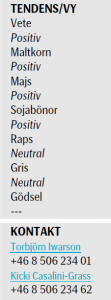 Centralbanken har också precis sänkt landets tillväxtprognos pga torkan. De åtgärder som ministrarna beslutade sig för var att öka stödet för dieselkonsumtion för jordbrukare, ökade stödet för utsäde. Man tog också bort importskatten på proteinmjöl. Man hade nämnt att man skulle diskutera att införa begränsningar i terminshandeln innan mötet, men detta gjorde man alltså inte. Skörden av linser, etc väntas bli avsevärt lägre i år än förra året, men landet har betydande lager sedan rekordskörden år 2007.
Centralbanken har också precis sänkt landets tillväxtprognos pga torkan. De åtgärder som ministrarna beslutade sig för var att öka stödet för dieselkonsumtion för jordbrukare, ökade stödet för utsäde. Man tog också bort importskatten på proteinmjöl. Man hade nämnt att man skulle diskutera att införa begränsningar i terminshandeln innan mötet, men detta gjorde man alltså inte. Skörden av linser, etc väntas bli avsevärt lägre i år än förra året, men landet har betydande lager sedan rekordskörden år 2007.
I Ryssland har den södra Krasnodar-regionen, en av få som nu är klara, skördat ca 5 mt spannmål, ungefär en tredjedel av förra årets skörd. På vissa ställen i västra Sibirien och Ural har temperaturen inte gått under 30 grader på över en månad, vilket också har lett till skogsbränder. Även om den ryska torkan är långt ifrån lika allvarlig som den i USA, har den extrema värmen fått landets jordbruksministerium att förra månaden sänka sin prognos för produktionen av spannmål till 80 mt, en minskning med 15 procent från förra året. I måndags sänkte Federal Metereorological and Environmental Monitoring Service sin prognos till 77 mt från 80 mt, något som förväntas följas av jordbruksministeriet. Ryssland behöver ca 72 mt spannmål för inhemska behov, och exporterar i allmänhet det som blir över. Oron över att Ryssland ska inför exportförbud eller exportrestriktioner kvarstår, men skulle kunna vara något som blir svårare för landet att införa i och med Rysslands inträde i WTO där reglerna för den globala handeln begränsar sådana genomföranden.
En nybildad kommission för tryggad livsmedelsförsöjning, som leds av Rysslands vice premiärminister Arkady Dvorkovich, kommer att träffas den 8 augusti för att diskutera spannmålssituationen i Ryssland.
Som ett resultat av det mycket torra vädret i vissa delar av Kazakstan förväntas landets spannmålsproduktion 2012 att sjunka kraftigt till drygt hälften av fjolårets rekordnivå. Men trots kraftigt minskad produktion, kommer sannolikt välfyllda lager att tillåta fortsatta höga exportvolymer under 2012/13. Per den 1 juli 2012 uppgick spannmåls-lagren till 9.8 mt, varav 9.4 mt vete.
Produktionen av vete förväntas sjunka till 12 mt, jämfört med rekordet på nästan 23 mt under 2011. Medan spannmålsarealen kvarstår stadigt på 16.3 miljoner hektar, ser man däremot betydande förändringar mellan grödor. Arealen för vete har sjunkit med 2%, medan den totala arealen för korn har ökat kraftigt med 140 000 hektar till 1.8 miljoner hektar med den största ökningen i de nordliga regionerna.
Torka i vissa norra delar av Buenos Aires, den provins där mer än hälften av all vete produceras, och i södra Cordoba provinsen i Argentina har börjat påverka 2012/13 års gröda, där lantbrukarna ännu inte är klara med sådden. Landet är världens 6:e största vete exportör och den största leverantören till grannlandet Brasilien. Regeringen uppskattar att landets lantbrukare kommer att så 3.8 miljoner hektar med grödan denna säsong, en minskning från 4.6 miljoner hektar förra säsongen. I förra veckan hade lantbrukarna sått 88% av den estimerade arealen, upp 9% från veckan innan. BAGE estimerar landets vete areal till 3,6 miljoner hektar och USDA beräknar Argentinas veteproduktion till 12 mt under 2012/13, en minskning från 14.5 mt förra säsongen.
Maltkorn
Novemberkontraktet på maltkorn ligger kvar över stödet på 260 euro. Så länge priset håller sig över den nivån tror vi att man bör avvakta med att sälja för att se om priset kan gå högre.
Potatis
Potatispriset för leverans nästa år, har fortsatt att röta sig i det prisintervall vi skrivit om tidigare, mellan 14 och 16 euro per deciton. Om priset går utanför intervallet är det en signal om att priset kan dra iväg, men så länge priset håller sig inom intervallet är 16 = högt pris och 14 = billigt pris.
Majs
Priset på decembermajs ligger nu kring 800 cent. Jämna siffror brukar dra till sig mycket handel, eftersom det är psykologiskt lättare för folk att lägga en order på ”800 cent”, än t ex ”792.25”. 800 cent är alltså ett motstånd. Det har gått mycket fort att handla upp priset och någon slags rekyl eller konsolidering ”borde” kunna äga rum.
Nedan ser vi den av USDA enligt WASDE-rapporterna väntade avkastningen i bushels per acre i USA.
Som vi ser är trenden stadigt uppåtriktad och Monsanto, t ex förutspår att det kommer att vara normalt med 300 bushels per acre år 2030. Längs vägarna i ”corn belt” kan man se skyltar som den reklamskylt vi ser nedanför:
Crop conditions rapporterades i måndags kväll som 24% av majsskörden i good eller excellent condition. Detta fick priserna naturligtvis att stiga ännu mer. Studerar vi förhållandet mellan crop condition och majspris ser vi att korrelationen över tiden mellan förändringar i crop condition och majspris är kraftigt negativ, som den borde vara. Vi ser detta nedan, med de faktiska noteringarna i den övre delen och korrelationen dem emellan i den nedre.
IGC (International Grains Council) kom med sin rapport i förra veckan och sänkte sin prognos kraftigt för den globala majsproduktionen 2012/13, med hänvisning till den värsta amerikanska torkan sedan 1956, och estimerar samtidigt att majslagren kommer att sjunka till ett sex-års-lägsta i slutet av säsongen. Den globala majsproduktionen beräknas nu uppgå till 864 mt, en nedjustering med 53 mt från tidigare prognos, vilket också är lägre än föregående säsongs 870 mt. Majsproduktionen i USA justeras ned med 50 mt till 300 mt, vilket är lägre än USDA’s senaste estimat på 329.5 mt.
Sojabönor
IGC (International Grains Council) kom med sin rapport i förra veckan (se tabellen ovan). Prognosen för den globala produktionen av sojabönor förväntas återhämta sig kraftigt under 2012/13, med en uppgång på 9% på årsbasis till 259 mt, även om prognosen hänger på en stark återhämtning av produktionen i Sydamerika där sådden börjar i fjärde kvartalet 2012. Däremot så justeras produktionen i USA ned med 8.3 mt till 79 mt. Nedan ser vi kursgrafen för november-bönorna. Vi ser att pristrenden är obruten uppåtriktad.
Nedan ser vi sojabönsodlarnas situation i USA. Det är ovanligt stora arealer som är i poor eller very poor condition. Andelen har ökat med 2%-enheter sedan förra veckan.
Celeres rapport visar att 41% av den brasilianska sojabönsskörden för 2012/13 har sålts, jämfört med 39% förra veckan och jämfört med 10% för ett år sedan. 97% av skörden 2011/12 har sålts, oförändrat från förra veckan och jämfört med 79% för ett år sedan.
Raps
Priset på novemberterminen befinner sig alltjämt i en obruten uppåtgående trend. 500 euro fungerar som ett starkt stöd. Skulle den nivån brytas finns nästa stöd på 480 euro.
Oil World höjer sin prognos för EU’s rapsproduktion, för andra gången på två veckor, till åtminstone 19.0 mt från tidigare 18.2 mt. Det blöta vårvädret har gynnat grödorna hos de ledande rapsproducenterna i Europa och den förväntade ökade avkastningen har justerats upp framförallt i Tyskland där produktionen beräknas uppgå till ca 4.9-5.0 mt och skörden där är nu avklarad till 20-25%. Produktionen i Frankrike beräknas uppgå till 5.4-5.5 mt, jämfört med förra årets 5.37 mt, utifrån en avkastning på 3.4-3.5 ton per hektar.
I Storbritannien däremot förväntas en minskning med 100 000 ton från förra årets rekordskörd på 2.7 mt, trots ökad sådd, men det är fortfarande oklart hur de senaste tidens kraftiga regn kommer att påverka grödorna. Med tanke på att rapsen noteras i euro, som är svag, kan man tänka sig högre priser (i euro) framöver.
Gris
Decemberkontraktet har etablerat ett bekräftat stödområde på 76 – 77 cent. Med högre foderkostnader och den minskande lönsamheten för grisproducenterna bör det finnas utsikter för ett högre pris på lean hogs.
Mjölk
Mjölkpriset drivs naturligtvis upp pga av torkan i USA och Ryssland, som även drabbar höproduktionen. Priset på skimmed milk powder på tyska börsen har fått från 1950 i maj till 2275 euro per ton idag, som vi ser i diagrammet för priset på spotkontraktet på tyska Eurex nedan.
Samtidigt kunde vi läsa på ATL.nu igår att Arla sänkt avräkningspriset till mjölbönder med motivationen ”Det är mycket, mycket mjölk i marknaden just nu och det pressar priserna hos alla bolag”.
På den amerikanska börsen, där torkan som drabbat foderproduktionen är mycket allvarligare än i Europa, har priset rusat. Nedan ser vi decemberkontraktet.
Socker
Priset på socker ligger fortfarande och balanserar: antingen bryts stödet och då för vi troligtvis en större prisnedgång mot 19 cent. – Eller så bryts motståndet som nu ligger på ca 23 cent, och då får vi antagligen en prisuppgång till 26 cent i första hand, kanske ännu mer.
[box]SEB Veckobrev Jordbruksprodukter är producerat av SEB Merchant Banking och publiceras i samarbete och med tillstånd på Råvarumarknaden.se[/box]
Disclaimer
The information in this document has been compiled by SEB Merchant Banking, a division within Skandinaviska Enskilda Banken AB (publ) (“SEB”).
Opinions contained in this report represent the bank’s present opinion only and are subject to change without notice. All information contained in this report has been compiled in good faith from sources believed to be reliable. However, no representation or warranty, expressed or implied, is made with respect to the completeness or accuracy of its contents and the information is not to be relied upon as authoritative. Anyone considering taking actions based upon the content of this document is urged to base his or her investment decisions upon such investigations as he or she deems necessary. This document is being provided as information only, and no specific actions are being solicited as a result of it; to the extent permitted by law, no liability whatsoever is accepted for any direct or consequential loss arising from use of this document or its contents.
About SEB
SEB is a public company incorporated in Stockholm, Sweden, with limited liability. It is a participant at major Nordic and other European Regulated Markets and Multilateral Trading Facilities (as well as some non-European equivalent markets) for trading in financial instruments, such as markets operated by NASDAQ OMX, NYSE Euronext, London Stock Exchange, Deutsche Börse, Swiss Exchanges, Turquoise and Chi-X. SEB is authorized and regulated by Finansinspektionen in Sweden; it is authorized and subject to limited regulation by the Financial Services Authority for the conduct of designated investment business in the UK, and is subject to the provisions of relevant regulators in all other jurisdictions where SEB conducts operations. SEB Merchant Banking. All rights reserved.
Analys
A sharp weakening at the core of the oil market: The Dubai curve

Down to the lowest since early May. Brent crude has fallen sharply the latest four days. It closed at USD 64.11/b yesterday which is the lowest since early May. It is staging a 1.3% rebound this morning along with gains in both equities and industrial metals with an added touch of support from a softer USD on top.

What stands out the most to us this week is the collapse in the Dubai one to three months time-spread.
Dubai is medium sour crude. OPEC+ is in general medium sour crude production. Asian refineries are predominantly designed to process medium sour crude. So Dubai is the real measure of the balance between OPEC+ holding back or not versus Asian oil demand for consumption and stock building.
A sharp weakening of the front-end of the Dubai curve. The front-end of the Dubai crude curve has been holding out very solidly throughout this summer while the front-end of the Brent and WTI curves have been steadily softening. But the strength in the Dubai curve in our view was carrying the crude oil market in general. A source of strength in the crude oil market. The core of the strength.
The now finally sharp decline of the front-end of the Dubai crude curve is thus a strong shift. Weakness in the Dubai crude marker is weakness in the core of the oil market. The core which has helped to hold the oil market elevated.
Facts supports the weakening. Add in facts of Iraq lifting production from Kurdistan through Turkey. Saudi Arabia lifting production to 10 mb/d in September (normal production level) and lifting exports as well as domestic demand for oil for power for air con is fading along with summer heat. Add also in counter seasonal rise in US crude and product stocks last week. US oil stocks usually decline by 1.3 mb/week this time of year. Last week they instead rose 6.4 mb/week (+7.2 mb if including SPR). Total US commercial oil stocks are now only 2.1 mb below the 2015-19 seasonal average. US oil stocks normally decline from now to Christmas. If they instead continue to rise, then it will be strongly counter seasonal rise and will create a very strong bearish pressure on oil prices.
Will OPEC+ lift its voluntary quotas by zero, 137 kb/d, 500 kb/d or 1.5 mb/d? On Sunday of course OPEC+ will decide on how much to unwind of the remaining 1.5 mb/d of voluntary quotas for November. Will it be 137 kb/d yet again as for October? Will it be 500 kb/d as was talked about earlier this week? Or will it be a full unwind in one go of 1.5 mb/d? We think most likely now it will be at least 500 kb/d and possibly a full unwind. We discussed this in a not earlier this week: ”500 kb/d of voluntary quotas in October. But a full unwind of 1.5 mb/d”
The strength in the front-end of the Dubai curve held out through summer while Brent and WTI curve structures weakened steadily. That core strength helped to keep flat crude oil prices elevated close to the 70-line. Now also the Dubai curve has given in.
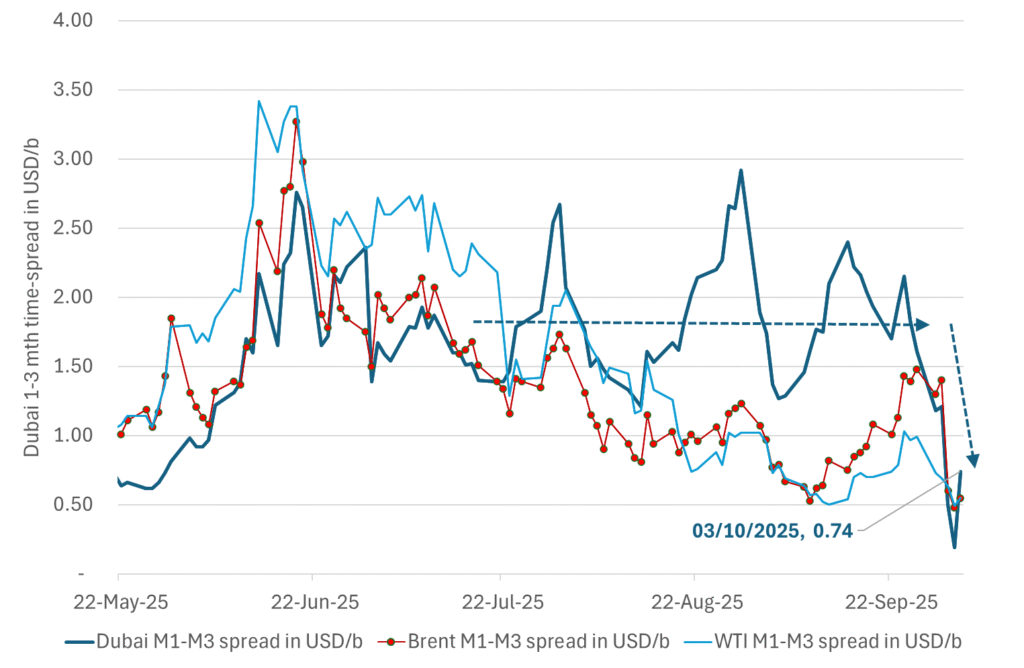
Brent crude oil forward curves

Total US commercial stocks now close to normal. Counter seasonal rise last week. Rest of year?
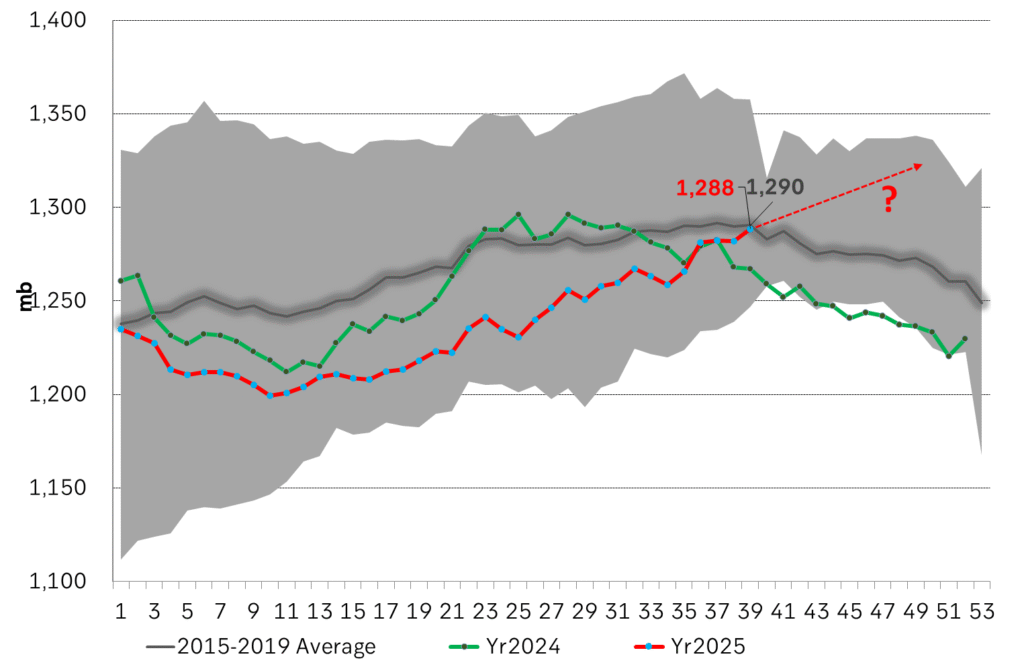
Total US crude and product stocks on a steady trend higher.
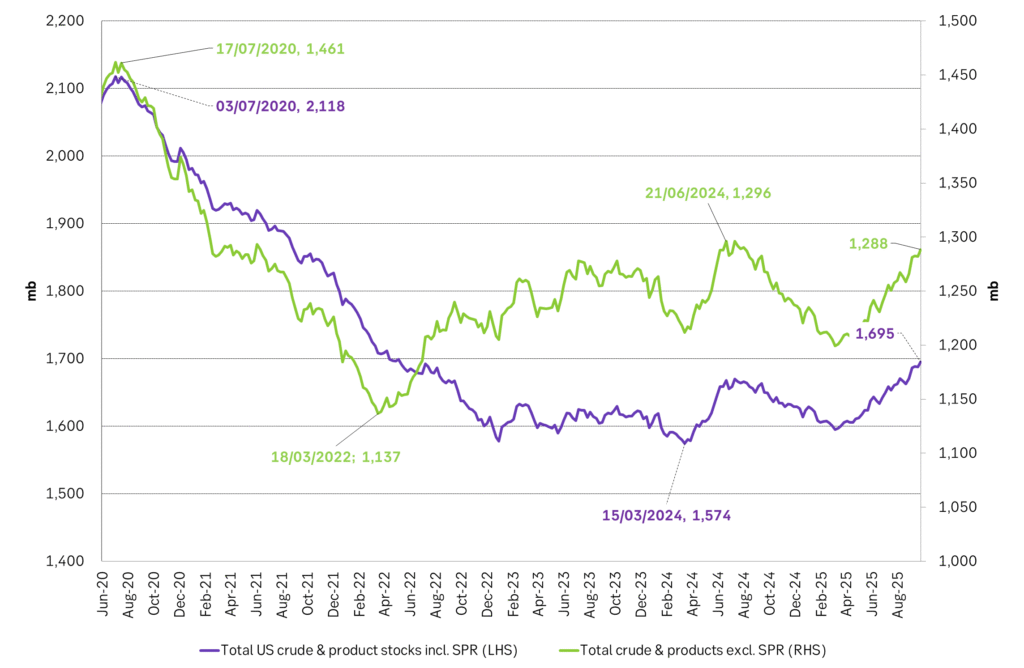
Analys
OPEC+ will likely unwind 500 kb/d of voluntary quotas in October. But a full unwind of 1.5 mb/d in one go could be in the cards

Down to mid-60ies as Iraq lifts production while Saudi may be tired of voluntary cut frugality. The Brent December contract dropped 1.6% yesterday to USD 66.03/b. This morning it is down another 0.3% to USD 65.8/b. The drop in the price came on the back of the combined news that Iraq has resumed 190 kb/d of production in Kurdistan with exports through Turkey while OPEC+ delegates send signals that the group will unwind the remaining 1.65 mb/d (less the 137 kb/d in October) of voluntary cuts at a pace of 500 kb/d per month pace.

Signals of accelerated unwind and Iraqi increase may be connected. Russia, Kazakhstan and Iraq were main offenders versus the voluntary quotas they had agreed to follow. Russia had a production ’debt’ (cumulative overproduction versus quota) of close to 90 mb in March this year while Kazakhstan had a ’debt’ of about 60 mb and the same for Iraq. This apparently made Saudi Arabia angry this spring. Why should Saudi Arabia hold back if the other voluntary cutters were just freeriding? Thus the sudden rapid unwinding of voluntary cuts. That is at least one angle of explanations for the accelerated unwinding.
If the offenders with production debts then refrained from lifting production as the voluntary cuts were rapidly unwinded, then they could ’pay back’ their ’debts’ as they would under-produce versus the new and steadily higher quotas.
Forget about Kazakhstan. Its production was just too far above the quotas with no hope that the country would hold back production due to cross-ownership of oil assets by international oil companies. But Russia and Iraq should be able to do it.
Iraqi cumulative overproduction versus quotas could reach 85-90 mb in October. Iraq has however steadily continued to overproduce by 3-5 mb per month. In July its new and gradually higher quota came close to equal with a cumulative overproduction of only 0.6 mb that month. In August again however its production had an overshoot of 100 kb/d or 3.1 mb for the month. Its cumulative production debt had then risen to close to 80 mb. We don’t know for September yet. But looking at October we now know that its production will likely average close to 4.5 mb/d due to the revival of 190 kb/d of production in Kurdistan. Its quota however will only be 4.24 mb/d. Its overproduction in October will thus likely be around 250 kb/d above its quota with its production debt rising another 7-8 mb to a total of close to 90 mb.
Again, why should Saudi Arabia be frugal while Iraq is freeriding. Better to get rid of the voluntary quotas as quickly as possible and then start all over with clean sheets.
Unwinding the remaining 1.513 mb/d in one go in October? If OPEC+ unwinds the remaining 1.513 mb/d of voluntary cuts in one big go in October, then Iraq’s quota will be around 4.4 mb/d for October versus its likely production of close to 4.5 mb/d for the coming month..
OPEC+ should thus unwind the remaining 1.513 mb/d (1.65 – 0.137 mb/d) in one go for October in order for the quota of Iraq to be able to keep track with Iraq’s actual production increase.
October 5 will show how it plays out. But a quota unwind of at least 500 kb/d for Oct seems likely. An overall increase of at least 500 kb/d in the voluntary quota for October looks likely. But it could be the whole 1.513 mb/d in one go. If the increase in the quota is ’only’ 500 kb/d then Iraqi cumulative production will still rise by 5.7 mb to a total of 85 mb in October.
Iraqi production debt versus quotas will likely rise by 5.7 mb in October if OPEC+ only lifts the overall quota by 500 kb/d in October. Here assuming historical production debt did not rise in September. That Iraq lifts its production by 190 kb/d in October to 4.47 mb/d (August level + 190 kb/d) and that OPEC+ unwinds 500 kb/d of the remining quotas in October when they decide on this on 5 October.
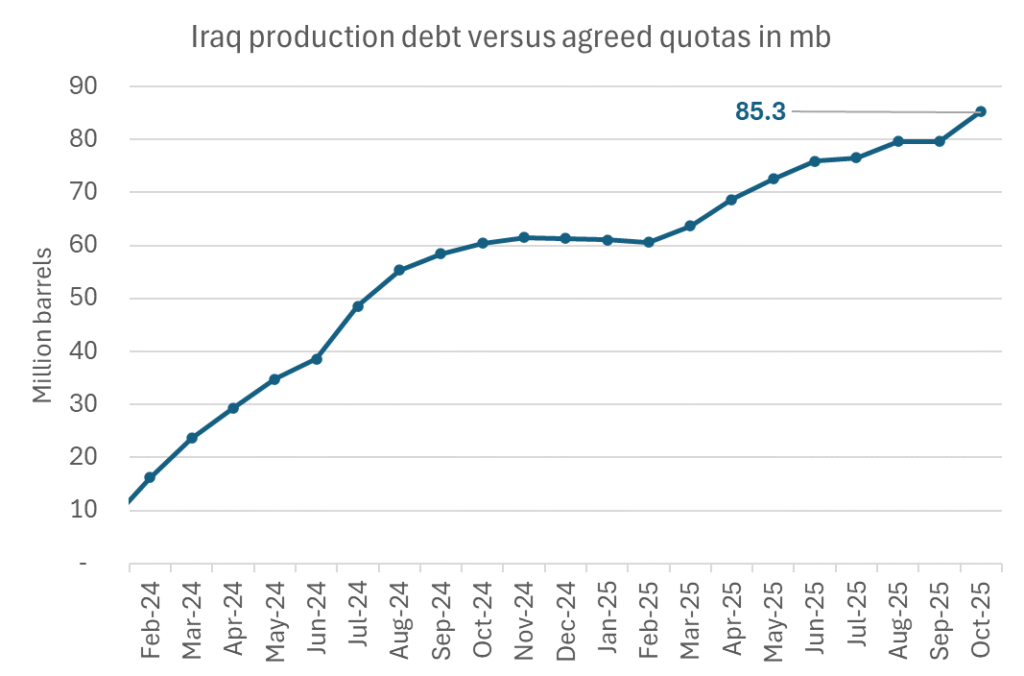
Analys
Modest draws, flat demand, and diesel back in focus

U.S. commercial crude inventories posted a marginal draw last week, falling by 0.6 million barrels to 414.8 million barrels. Inventories remain 4% below the five-year seasonal average, but the draw is far smaller than last week’s massive 9.3-million-barrel decline. Higher crude imports (+803,000 bl d WoW) and steady refinery runs (93% utilization) helped keep the crude balance relatively neutral.

Yet another drawdown indicates commercial crude inventories continue to trend below the 2015–2022 seasonal norm (~440 million barrels), though at 414.8 million barrels, levels are now almost exactly in line with both the 2023 and 2024 trajectory, suggesting stable YoY conditions (see page 3 attached).
Gasoline inventories dropped by 1.1 million barrels and are now 2% below the five-year average. The decline was broad-based, with both finished gasoline and blending components falling, indicating lower output and resilient end-user demand as we enter the shoulder season post-summer (see page 6 attached).
On the diesel side, distillate inventories declined by 1.7 million barrels, snapping a two-week streak of strong builds. At 125 million barrels, diesel inventories are once again 8% below the five-year average and trending near the low end of the historical range.
In total, commercial petroleum inventories (excl. SPR) slipped by 0.5 million barrels on the week to ish 1,281.5 million barrels. While essentially flat, this ends a two-week streak of meaningful builds, reflecting a return to a slightly tighter situation.
On the demand side, the DOE’s ‘products supplied’ metric (see page 6 attached), a proxy for implied consumption, softened slightly. Total demand for crude oil over the past four weeks averaged 20.5 million barrels per day, up just 0.9% YoY.
Summing up: This week’s report shows a re-tightening in diesel supply and modest draws across the board, while demand growth is beginning to flatten. Inventories remain structurally low, but the tone is less bullish than in recent weeks.
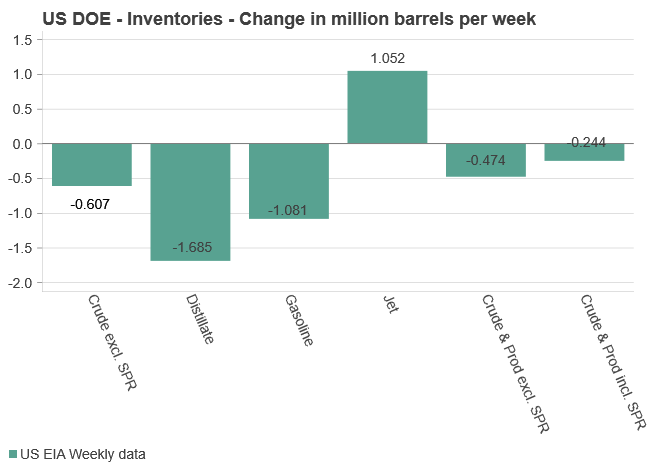
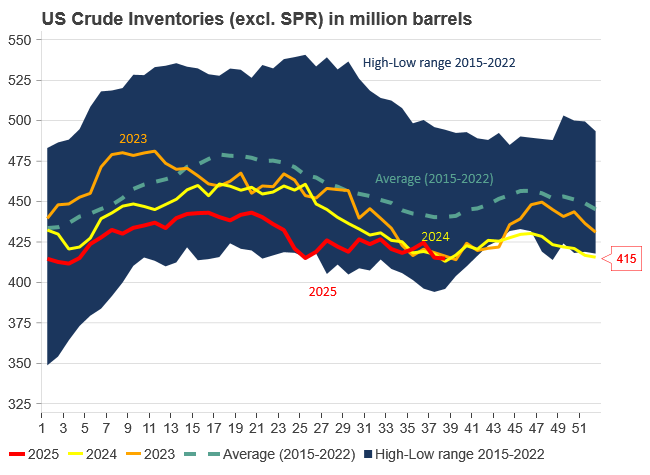
-

 Nyheter4 veckor sedan
Nyheter4 veckor sedanEurobattery Minerals satsar på kritiska metaller för Europas självförsörjning
-

 Nyheter3 veckor sedan
Nyheter3 veckor sedanMahvie Minerals i en guldtrend
-

 Nyheter4 veckor sedan
Nyheter4 veckor sedanGuldpriset kan närma sig 5000 USD om centralbankens oberoende skadas
-

 Nyheter4 veckor sedan
Nyheter4 veckor sedanOPEC signalerar att de inte bryr sig om oljepriset faller kommande månader
-

 Analys3 veckor sedan
Analys3 veckor sedanVolatile but going nowhere. Brent crude circles USD 66 as market weighs surplus vs risk
-
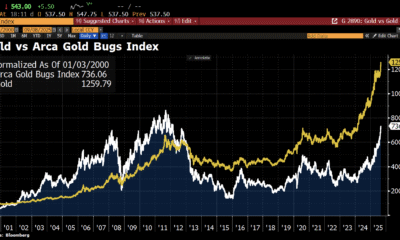
 Nyheter3 veckor sedan
Nyheter3 veckor sedanAktier i guldbolag laggar priset på guld
-

 Nyheter3 veckor sedan
Nyheter3 veckor sedanKinas elproduktion slog nytt rekord i augusti, vilket även kolkraft gjorde
-

 Nyheter3 veckor sedan
Nyheter3 veckor sedanTyskland har så höga elpriser att företag inte har råd att använda elektricitet


